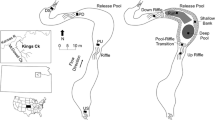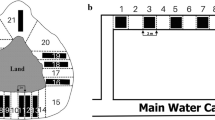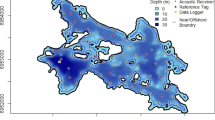Abstract
Movement of individuals throughout a landscape is fundamental to a wide array of ecological processes; however, the interacting spatiotemporal effects of environmental influences on movement remain poorly understood. Using a series of mesocosm trials, we examined relationships between local abiotic and biotic variables and movement patterns of the blackspotted topminnow, Fundulus olivaceus, using passive integrated transponder (PIT) tags. In one series of trials, we assessed the influence of local population factors (density, sex ratio) and phenotypic variables (growth, condition) on movement rates across seasons (spawning, nonspawning). Movement was strongly influenced by different factors seasonally, and movement rates were approximately 7.5 times higher in the spawning season compared to nonspawning periods. Males moved more than females and movement was greater in low-density treatments; however, these patterns persisted only during the spawning period. In a second series of trials, we examined abiotic (habitat complexity) and biotic (predator; Micropterus punctulatus) influences on the movement dynamics and habitat usage of F. olivaceus. Predators were found to suppress movement; however, this response was ameliorated by the presence of habitat structure. Movement rates of F. olivaceus were negatively related to predator movement and individuals showed a higher propensity to group in the presence of the predator. The predator induced shifts in habitat usage, as individuals utilized the shallower habitat at a greater frequency and for longer durations compared to trials without a predator. Taken together, our results suggest local environmental variables may strongly influence spatiotemporal movement behaviors of F. olivaceus.





Similar content being viewed by others
References
Albanese B, Angermeier PL, Dorai-Raj S (2004) Ecological correlates of fish movement in a network of Virginia streams. Can J Fish Aquat Sci 61:857–869
Alldredge P, Gutierrez M, Duvernell D, Schaefer J, Brunkow P, Matamoros W (2011) Variability in movement dynamics of topminnow (Fundulus notatus and F. olivaceus) populations. Ecol Freshw Fish 20:513–521
Ammann AJ, Michel CJ, MacFarlane RB (2013) The effects of surgically implanted acoustic transmitters on laboratory growth, survival and tag retention in hatchery yearling Chinook salmon. Environ Biol Fish 96:135–143
Aparicio E, De Sostoa A (1999) Pattern of movements of adult Barbus haasi in a small Mediterranean stream. J Fish Biol 55:1086–1095
Bell AV, Rader RB, Peck SL, Sih A (2009) The positive effects of negative interactions: can avoidance of competitors or predators increase resource sampling by prey? Theor Popul Biol 76:52–58
Blanchard TA (1996) Ovarian cycles and microhabitat use in two species of topminnow, Fundulus olivaceus and F. euryzonus, from the southeastern United States. Environ Biol Fish 47:155–163
Bonte D, de la Pena E (2009) Evolution of body condition-dependent dispersal in metapopulations. J Evol Biol 22:1242–1251
Bowler DE, Benton TG (2005) Causes and consequences of animal dispersal strategies: relating individual behaviour to spatial dynamics. Biol Rev 80:205–225
Braasch ME, Smith PW (1965) Relationships of the topminnows Fundulus notatus and Fundulus olivaceus in the upper Mississippi River valley. Copeia 1965:46–53
Brown RS, Cooke SJ, Anderson WG, McKinley RS (1999) Evidence to challenge the “2% rule” for biotelemetry. N Am J Fish Manag 19:867–871
Carranza J, Winn HE (1954) Reproductive behavior of the blackstripe topminnow, Fundulus notatus. Copeia 1954:273–278
Chipps SR, Clapp DF, Wahl DH (2000) Variation in routine metabolism of juvenile muskellunge: evidence for seasonal metabolic compensation in fishes. J Fish Biol 56:311–318
Cooke SJ, Midwood JD, Thiem JD, Klimley P, Lucas MC, Thorstad EB, Eiler J, Holbrook C, Ebner BC (2013) Tracking animals in freshwater with electronic tags: past, present and future. Anim Biotelem 1:5
Croft DP, Albanese B, Arrowsmith BJ, Botham M, Webster M, Krause J (2003) Sex-biased movement in the guppy (Poecilia reticulata). Oecologia 137:62–68
Crook DA (2004) Is the home range concept compatible with the movements of two species of lowland river fish? J Anim Ecol 73:353–366
Dixon CJ, Mesa MG (2011) Survival and tag loss in Moapa White River Springfish implanted with passive integrated transponder tags. T Am Fish Soc 140:1375–1379
Flaxman SM, Lou Y, Meyer FG (2011) Evolutionary ecology of movement by predators and prey. Theor Ecol 4:255–267
Fraser DF, Cerri RD (1982) Experimental evaluation of predator–prey relationships in a patchy environment: consequences for habitat use patterns in minnows. Ecology 63:307–313
Fraser DF, Gilliam JF, Yip-Hoi T (1995) Predation as an agent of population fragmentation in a tropical watershed. Ecology 76:1461–1472
Frissell CA, Liss WJ, Warren CE, Hurley MD (1986) A hierarchical framework for stream habitat classification: viewing streams in a watershed context. Environ Manage 10:199–214
Gandon S (1999) Kin competition, the cost of inbreeding and the evolution of dispersal. J Theor Biol 200:345–364
Gandon S, Michalakis Y (2001) Multiple causes of the evolution of dispersal. In: Clobert J, Danchin E, Dhont AA, Nichols JD (eds) Dispersal. Oxford University Press, Oxford, pp 155–167
Gatz AJ, Adams SM (1994) Patterns of movement of centrarchids in two warmwater streams in eastern Tennessee. Ecol Freshw Fish 3:35–48
Gilliam JF, Fraser DF (2001) Movement in corridors: enhancement by predation threat, disturbance, and habitat structure. Ecology 82:258–273
Gorman OT (1986) Assemblage organization of stream fishes: the effect of rivers on adventitious streams. Am Nat 128:611–616
Gowan C (2007) Short-term cues used by foraging trout in a California stream. Environ Biol Fish 78:317–331
Gowan C, Fausch KD (1996) Mobile brook trout in two high-elevation Colorado streams: reevaluating the concept of restricted movement. Can J Fish Aquat Sci 53:1370–1381
Greenwood PJ (1980) Mating systems, philopatry and dispersal in birds and mammals. Anim Behav 28:1140–1162
Gros A, Hovestadt T, Poethke HJ (2008) Evolution of sex-biased dispersal: the role of sex-specific dispersal costs, demographic stochasticity, and inbreeding. Ecol Model 219:226–233
Gurarie E, Ovaskainen O (2011) Characteristic spatial and temporal scales unify models of animal movement. Am Nat 178:113–123
Hamilton WD, May RM (1977) Dispersal in stable habitats. Nature 269:578–581
Harris JA (2013) Convergence of life history phenotypes in two species of topminnows, Fundulus notatus and Fundulus olivaceus. Masters Thesis, The University of Southern Mississippi
Harvey BC (1991) Interactions among stream fishes: predator-induced habitat shifts and larval survival. Oecologia 87:29–36
Harvey BC, Nakamoto RJ, White JL (1999) Influence of large woody debris and a bankfull flood on movement of adult resident coastal cutthroat trout (Oncorhynchus clarki) during fall and winter. Can J Fish Aquat Sci 56:2161–2166
Ims RA, Hjermann DÃ (2001) Condition-dependent dispersal. In: Clobert J, Danchin E, Dhont AA, Nichols JD (eds) Dispersal. Oxford University Press, Oxford, pp 203–216
Jepsen N, Koed A, Thorstad EB, Baras E (2002) Surgical implantation of telemetry transmitters in fish: how much have we learned? Hydrobiologia 483:239–248
Knaepkens G, Maerten E, Tudorache C, De Boeck G, Eens M (2007) Evaluation of passive integrated transponder tags for marking the bullhead (Cottus gobio), a small benthic freshwater fish: effects on survival, growth and swimming capacity. Ecol Freshw Fish 16:404–409
Knight GL, Gido KB (2005) Habitat use and susceptibility to predation of four prairie stream fishes: implications for conservation of the endangered Topeka shiner. Copeia 2005:38–47
Kobler A, Klefoth T, Wolter C, Fredrich F, Arlinghaus R (2008) Contrasting pike (Esox lucius L.) movement and habitat choice between summer and winter in a small lake. Hydrobiologia 601:17–27
Koed A, Balleby K, Mejlhede P, Aarestrup K (2006) Annual movement of adult pike (Esox lucius L.) in a lowland river. Ecol Freshw Fish 15:191–199
Lawrence WS (1987) Dispersal: an alternative mating tactic conditional on sex ratio and body size. Behav Ecol Sociobiol 21:367–373
Le Galliard JF, Ferriére R, Clobert J (2003) Mother-offspring interactions affect natal dispersal in a lizard. Proc R Soc Lond B 270:1163–1169
Lehmann L, Perrin N (2003) Inbreeding avoidance through kin recognition: choosy females boost male dispersal. Am Nat 162:638–652
Lima SL, Dill LM (1990) Behavioral decisions made under the risk of predation: a review and prospectus. Can J Zool 68:619–640
Lucas MC, Batley E (1996) Seasonal movements and behaviour of adult barbel Barbus barbus, a riverine cyprinid fish: implication for river management. J Appl Ecol 33:1345–1358
Matthews WJ, Gido KB, Garrett GP, Gelwick FP, Stewart JG, Schaefer J (2006) Modular experimental riffle-pool stream system. T Am Fish Soc 135:1559–1566
Matthysen E (2005) Density-dependent dispersal in birds and mammals. Ecography 28:403–416
Matthysen E (2012) Multicausality of dispersal: a review. In: Clobert J, Baguette M, Benton TG, Bullock JM (eds) Dispersal ecology and evolution. Oxford University Press, Oxford, pp 3–18
Nathan R, Getz WM, Revilla E, Holyoak M, Kadmon R, Saltz D, Smouse PE (2008) A movement ecology paradigm for unifying organismal movement research. Proc Natl Acad Sci U S A 105:19052–19059
Perrin N, Mazalov V (1999) Dispersal and inbreeding avoidance. Am Nat 154:282–292
Perrin N, Mazalov V (2000) Local competition, inbreeding, and the evolution of sex-biased dispersal. Am Nat 155:116–127
Petty JT, Grossman GD (2004) Restricted movement by mottled sculpin (Pisces: Cottidae) in a southern Appalachian stream. Freshwater Biol 49:631–645
Poethke HJ, Weisser WW, Hovestadt T (2010) Predator-induced dispersal and the evolution of conditional dispersal in correlated environments. Am Nat 175:577–586
Power ME (1984) Habitat quality and the distribution of algae-grazing catfish in a Panamanian stream. J Anim Ecol 53:357–374
Power ME, Matthews WJ, Stewart AJ (1985) Grazing minnows, piscivorous bass, and stream algae: dynamics of a strong interaction. Ecology 66:1448–1456
R Core Team (2014) R: A language and environment for statistical computing. R Foundation for Statistical Computing, version 2.15, Vienna, Austria, http://www.R-project.org/
Roberts JH, Angermeier PL (2007) Spatiotemporal variability of stream habitat and movement of three species of fish. Oecologia 151:417–430
Ross ST (2001) Inland fishes of Mississippi. University Press of Mississippi, Jackson
Sandell M, Agrell J, Erlinge S, Nelson J (1990) Natal dispersal in relation to population density and sex ratio in the field vole, Microtus agrestis. Oecologia 83:145–149
Schaefer J (2001) Riffles as barriers to interpool movement by three cyprinids (Notropis boops, Campostoma anomalum and Cyprinella venusta). Freshwater Biol 46:379–388
Schaefer J, Walters A (2010) Metabolic cold adaptation and developmental plasticity in metabolic rates among species in the Fundulus notatus species complex. Funct Ecol 24:1087–109
Schaefer JF, Duvernell DD, Kreiser BR, Champagne C, Clark SR, Gutierrez M, Stewart LK, Coleman C (2012) Evolution of a sexually dimorphic trait in a broadly distributed topminnow (Fundulus olivaceus). Ecol Evol 2:1371–1381
Schlosser IJ (1988a) Predation risk and habitat selection by two size classes of a stream cyprinid: experimental test of a hypothesis. Oikos 52:36–40
Schlosser IJ (1988b) Predation rates and the behavioral response of adult brassy minnows (Hybognathus hankinsoni) to creek chub and smallmouth bass predators. Copeia 1988:691–698
Schlosser IJ (1995) Critical landscape attributes that influence fish population dynamics in headwater streams. Hydrobiologia 303:71–81
Shaw AK, Kokko H (2014) Mate finding, Allee effects, and selection for sex-biased dispersal. J Anim Ecol 83:1256–1267
Skalski GT, Gilliam JF (2000) Modeling diffusive spread in a heterogeneous population: a movement study with stream fish. Ecology 81:1685–1700
Thomerson JE, Wooldridge DP (1970) Food habits of allotopic and syntopic populations of the topminnows Fundulus olivaceus and Fundulus notatus. Am Midl Nat 84:573–576
Vigueira PA, Schaefer JF, Duvernell DD, Kreiser BR (2008) Tests of reproductive isolation among species in the Fundulus notatus (Cyprinodontiformes: Fundulidae) species complex. Evol Ecol 22:55–70
Weisser WW (2001) The effects of predation on dispersal. In: Clobert J, Danchin E, Dhont AA, Nichols JD (eds) Dispersal. Oxford University Press, Oxford, pp 180–188
Werner EE, Mittelbach GG, Hall DJ, Gilliam JF (1983) Experimental tests of optimal habitat use in fish: the role of relative habitat profitability. Ecology 64:1525–1539
Wesner JS (2010) Aquatic predation alters a terrestrial prey subsidy. Ecology 91:1435–1444
Wisenden BD, Harter KR (2001) Motion, not shape, facilitates association of predation risk with novel objects by fathead minnows (Pimephales promelas). Ethology 107:357–364
Acknowledgments
We thank J. Harris, L. Stewart, B. Kreiser, C. Qualls, M. Davis, J. Barr, C. Coleman, N. Frazier, and W. Matamoros for assistance in various aspects of this project and two anonymous reviewers for valuable comments that improved the quality of the manuscript.
Author information
Authors and Affiliations
Corresponding author
Ethics declarations
Conflict of interest
The authors declare that they have no conflict of interest.
Funding
The study was funded by the National Science Foundation (DEB no. 0716985) awarded to JFS.
Ethical approval
All applicable institutional and national guidelines for the care and use of animals were followed. All procedures performed on animals were in accordance with The University of Southern Mississippi’s Institutional Animal Care and Use Committee (US Public Health Service Animal Welfare Assurance Number A3851-01) and carried out under the University of Southern Mississippi’s IACUC protocol no. 13041102.
Additional information
Communicated by K. Lindström
Rights and permissions
About this article
Cite this article
Clark, S.R., Schaefer, J.F. Ecological influences on the local movement dynamics of the blackspotted topminnow, Fundulus olivaceus . Behav Ecol Sociobiol 70, 557–567 (2016). https://doi.org/10.1007/s00265-016-2073-7
Received:
Revised:
Accepted:
Published:
Issue Date:
DOI: https://doi.org/10.1007/s00265-016-2073-7




